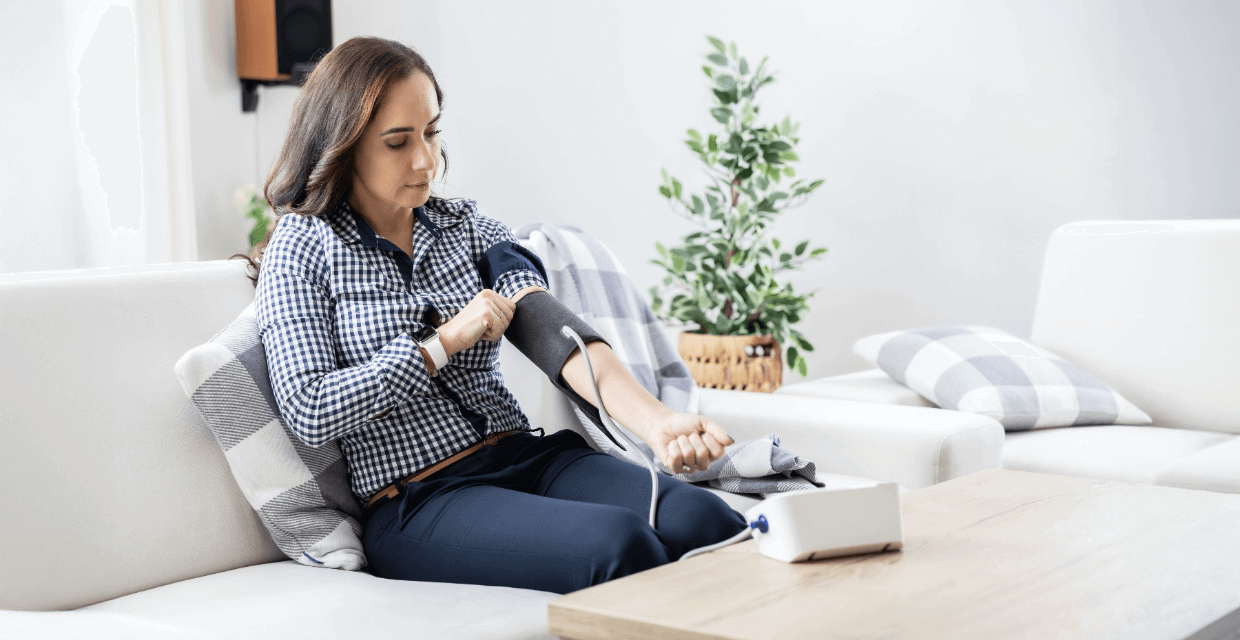Home Blood Pressure Monitoring: What You Need to Know
Hypertension or high blood pressure affects millions of individuals, especially adults, worldwide. It is a potential risk factor for heart diseases, stroke, and problems related to the kidneys. Hypertension is when the pressure in your blood vessels is too high (140/90 mmHg or higher). If left undiagnosed, it can become an underlying cause of a serious health problem.
The good thing is that managing blood pressure is easy and can be done by monitoring your readings regularly and making necessary modifications in your lifestyle and diet. With so many blood pressure monitoring devices and brands available, one can easily monitor their readings at home.
In this blog, we’ll look into the importance of home blood pressure monitoring, how it works, and its benefits.
Why Is Home Blood Pressure Monitoring Important?
Regular blood pressure monitoring is important for people who have been diagnosed with hypertension, those at risk, and those already on medication to control their fluctuating blood pressure levels.
Traditionally, blood pressure was measured in the doctor’s office. This approach had its drawback as only single assessment of a patient’s reading was done. Moreover some patients experience a rise in blood pressure due to an anxiety of a healthcare visit, often making readings invalid. This is also known as white coat syndrome, as the temporary rise resulting in inaccurate readings.
Home blood pressure monitoring provides a far better insight into a person’s health status compared to tradition in-clinic monitoring. When equipped with home monitors, patients can check their own blood pressure over time and share that information with their doctors, resulting in making informed decisions and personalized care plans.
What Is a Blood Pressure Monitoring Program?
Blood pressure monitoring program refers to an arrangement in which individuals are counseled and encouraged to take their BP readings on a timely basis and keep track of the same at home. This program often includes the provision of a home BP monitor, along with instructions on how to use it appropriately. A lot of virtual care providers run online blood pressure monitor programs to help control their patients’ hypertension remotely.
The main purpose of this program is not only to monitor and control blood pressure but also to empower patients in the management of their health. Through consistent monitoring of blood pressure, patients tend to be involved in their treatment, which has a positive impact on outcomes.
How does Home Blood Pressure Monitoring Works?
Home blood pressure monitors tend to use electronic techniques in taking readings, using inflatable cuffs placed around the arm or wrist. Most modern monitors are designed with a single button that is pressed to take the reading. Here’s how it really works:
1. Cuff Inflation: The cuff inflates around the arm or wrist, momentarily stopping blood flow in the artery.
2. Measurement: The monitor then gradually deflates the cuff and measures the pressure in the artery as blood starts to flow again.
3. Reading: The monitor provides two main readings: systolic pressure (the higher number: measures the pressure as the heart beats) and diastolic pressure (the lower number: measures the pressure as the heart relaxes between the beats). These readings are displayed on the digital screen for easy tracking over time.
Factors to Keep in Mind When Choosing the Best Blood Pressure Monitor
In order to buy the right blood pressure monitor for self-monitoring from home, there are some factors you should consider for accuracy and ease of use:
· Type of Monitor: There are basically two kinds of blood pressure monitors available in the market, i.e. upper arm monitors and wrist monitors. Though upper arm monitors are considered the best in terms of overall accuracy, they are comparatively difficult to use by quick checkers and slim individuals.
· Clinical Validation: Use clinically validated monitors for accuracy that are checked and tested by prominent service providers, such as the AHA and the BHS for reliability.
· Ease of Use: It is one of the important factors to consider. Make sure the monitor should be easy to use with large and clear numbers, along with clutter-free interface. A few of the advanced monitors may have additional features like detection of irregular heartbeat, memory storage, and the ability to sync with mobile apps to facilitate better tracking.
· Affordability: There are many home blood pressure monitors available at different price ranges, but some of them are pretty much affordable. However, investing in a quality monitor could be worth it as it ensures reliable readings.
Advantages of Home Blood Pressure Monitoring
The combination of home blood pressure monitoring with connected health devices delivers several benefits to patients, including:
· Better Control of Blood Pressure
· Convenience and Ease of Use
· Reduced Anxiety
· Enhanced Patient Engagement
· Prevention of Complications
· Cost-Effective Monitoring
Steps to Use a Blood Pressure Monitor at Home
Home use of a blood pressure monitor takes a bit of practice before one can be sure of the reading obtained. Here are a few steps on optimizing the use of a blood pressure monitor at home:
Right Time: The right time to measure blood pressure is at the same time every day, preferably in the morning, and before eating or drinking anything. Do not measure blood pressure after exercise or stressful moments or caffeine intake.
Sit Properly: For maximum comfort, sit in a comfortable armchair that supports your back. Lay your feet evenly flat on the floor and rest your arm on a flat surface that is at heart level.
Read and Follow All Instructions: Read instructions that come with a blood pressure monitor. The cuff should be snug but not too tight, and it should be tied directly over the skin (not over clothes).
Read Twice or Thrice: Take at least two to three readings a minute apart, and record the average reading.
Monitor Your Readings: Keep an eye on your readings over time to see patterns of change. Many blood pressure monitors come with memory storage for past readings that you can use to track your BP trend.
Conclusion
Home-based blood pressure measurements play a significant role in hypertension control and overall cardiovascular wellbeing. Connected health devices and remote health monitoring via online hypertension programs allow patients to take charge of their health-from within the comfort of their homes. This provides an opportunity for patients to play an active role in their health management and decreases the risk for complications.
It is important for individuals to conduct regular monitoring of their BP and track the progress made to ensure their condition remains stable. They would, therefore, be able to make decisions more appropriately where their health is concerned, leading to a treatment plan with fewer risks and better effects. For those people who have been diagnosed with high blood pressure or fear it might become a problem, home monitoring is a vital aspect in moving towards better health.
If you need to consult experts before you start with blood pressure monitoring, feel free to talk to our qualified physicians at MDChronic. We are a virtual care platform that can help patients get their hypertension and blood pressure related health conditions diagnosed and treated right from the comfort of the home. Feel free to contact us for a health advice.



